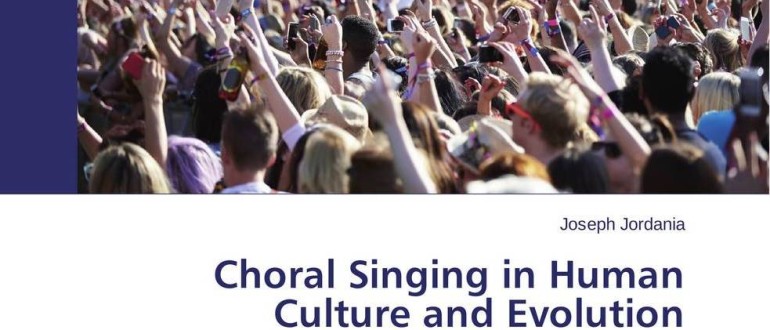Maps and musical examples for book Choral Singing in Human Culture and Evolution
You can find here 15 maps of distribution of various styles of traditional polyphony in Europe and the world, a map of distribution of stuttering in the world, and also 49 musical examples from various world cultures. These maps and musical examples are complementary to Joseph Jordania’s book “Choral Singing in Human Culture and Evolution” (Lambert Academic Publishers, Saarbrucken, 2015).
This book is the second revised and extended edition of Joseph Jordania’s 2006 book “Who Asked the First Question? Origins of Human Choral Singing, Intelligence, Language and Speech” (Tbilisi State University, Logos, 2006)You can see more detailed information on the audio examples in the book “Choral Singing in Human Culture and Evolution (pages 663-668).
Maps:
01. Distribution of drone-dissonant polyphony in Europe
02. Distribution of variant-heterophony in Europe
03. Distribution of chordal-triadic polyphony in Europe
04. Distribution of melismatic-chordal polyphony in Europe
05. Distribution of melismatic-rubato polyphony in Europe
06. Combined map of distribution of polyphonic styles in Europe
07. Distribution of drone polyphony throughout the world
08. Distribution of ostinato polyphony throughout the world
09. Distribution of parallel polyphony throughout the world
10. Distribution of variant-heterophony throughout the world
11. Distribution of canonic polyphony throughout the world
12. Distribution of chordal-triadic polyphony throughout the world
13. Distribution of free (counterpoint) polyphony throughout the world
14. Combined map of distribution of various types of polyphony throughout the world
15. Distribution of monophony and polyphony throughout the world
16. World map of stuttering prevalence
Audio examples:
01. Central African Pygmy polyphony. Courtesy of Simha Arom and “Rounder”
02. Tanzania, Wagogo tribe. Courtesy of Polo Vallejo and Ocora/Radio France
03. Tanzania, Wagogo tribe. Courtesy of Polo Vallejo and Ocora/Radio France
04. Russian polyphony. Courtesy of Maria Roditeleva
05. Russian polyphony. Courtesy of Maria Roditeleva
06. Tatarstan polyphony. Courtesy of Nailia Almeeva
07. Tatarstan polyphony. Courtesy of Nailia Almeeva
11. Adighian (Circassian) polyphony. Courtesy of Alla Sokolova and Zamudin Guchev
12. Chechen polyphony. Courtesy of Michael Church and Topic Records
13. Ossetian polyphony. Courtesy of Michael Church and Topic Records
14. Georgian polyphony, Svaneti, Courtesy of ensemble “Basiani”
15. Georgian polyphony, women from Racha, courtesy of ensemble “Mzetamze” and Face Music Switzerland
16. Georgian polyphony, Kakheti, Courtesy of ensemble “Basiani”
17. Georgian polyphony, Guria, Courtesy of Anzor Erkomaishvili
18. Georgian polyphony, Achara, Courtesy of ensemble “Basiani”
19. Ukrainian polyphony, Courtesy of Evgeni Efremov
20. Lithuanian polyphony, Courtesy of Daiva Raciunaite
21. Lithuanian polyphony, Courtesy of Daiva Raciunaite
22. Latvian polyphony. Courtesy of Gita Lancere and ensemble “Saucejas”
23. Latvian polyphony. Courtesy of Gita Lancere and ensemble “Saucejas”
24. Bulgarian polyphony. Courtesy of Florian Messner
25. Bosnia-Herzegovina polyphony. Courtesy of Dieter Christensen
26. Albanian polyphony, Courtesy of Michael Church
27. Corsican polyphony. Courtesy of Frédéric Vesperini and ensemble “Spartimu”
28. Corsican polyphony. Courtesy of Frédéric Vesperini and ensemble “Spartimu”
29. Corsican polyphony. Courtesy of Frédéric Vesperini and ensemble “Spartimu”
30. Portugal polyphony. Courtesy of José Alberto Sardinha
31. Portugal polyphony. Courtesy of José Alberto Sardinha
32. Portugal polyphony. Courtesy of José Alberto Sardinha
33. Portugal polyphony. Courtesy of José Alberto Sardinha
34. Portugal polyphony. Courtesy of José Alberto Sardinha
35. Persian Gulf, Bahrain polyphony. Courtesy of Scheherazade Hassan
36. Oman, Bedouin polyphony. Courtesy of Dieter Christensen.
37. Nuristan (Afghanistan) polyphony. Courtesy of the Vienna Phonogram-Archive
39. Tuva overtone singing. Courtesy of Ted Levin
40. Yakutian heterophony. Courtesy of Eduard Alexeev
41. Ainu (North Japan) polyphony. Courtesy of Kazuyuki Tanimoto
42. Ainu (North Japan) polyphony. Courtesy of Kazuyuki Tanimoto
43. Taiwan polyphony. Courtesy of Lu Yuhsiu and Paul Knight
44. Taiwan polyphony. Courtesy of Lu Yuhsiu and Paul Knight
45. Flores polyphony. Courtesy of Gerald Florian Messner
46. Melanesian polyphony. Courtesy of Gerald Florian Messner





